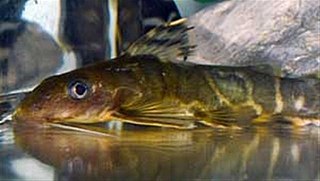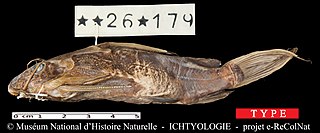
Cavefish or cave fish is a generic term for fresh and brackish water fish adapted to life in caves and other underground habitats. Related terms are subterranean fish, troglomorphic fish, troglobitic fish, stygobitic fish, phreatic fish, and hypogean fish.
Congoglanis alula is a species of loach catfish found in the Congo River Basin in Angola, the Democratic Republic of Congo and possibly in Zambia. It reaches lengths up to 14.1 centimetres (5.6 in) SL.
Malapterurus melanochir is a species of electric catfish endemic to the Democratic Republic of the Congo, where it occurs in the upper and middle Congo River basin. This species grows to a length of 98 centimetres (39 in) SL.
Paradoxoglanis caudivittatus is a species of electric catfish endemic to the Democratic Republic of the Congo where it is found in the Tshuapa and Lukenie River systems. This species grows to a length of 12.5 centimetres (4.9 in) SL.
Paradoxoglanis parvus is a species of electric catfish endemic to the Democratic Republic of the Congo, where it is found in the Congo and Kumbinanimi River systems. This species grows to a length of 16.9 centimetres (6.7 in) SL.
Atopochilus christyi is a species of upside-down catfish endemic to the Democratic Republic of the Congo. It occurs in the Ituri, Itimbri and Kasai Rivers as well as the Kinsuka Rapids and Boyoma Falls. This species grows to a length of 9.5 centimetres (3.7 in) SL.
Atopochilus mandevillei is a species of upside-down catfish endemic to the Democratic Republic of the Congo where it occurs in the Kinsuka Rapids. This species grows to a length of 14.1 centimetres (5.6 in) TL.

Atopochilus savorgnani is a species of upside-down catfish native to Cameroon where it is found in the Ntem River, Equatorial Guinea where it occurs in Río Muni and Gabon where it is found in the upper Ogowe River.

Chiloglanis batesii is a species of upside-down catfish found widely in Western and Central Africa. This species grows to a length of 4.7 centimetres (1.9 in) TL.
Synodontis aterrimus, known as the network synodontis, is a species of upside-down catfish that is endemic to the Democratic Republic of the Congo where it is found in the middle Congo Basin. It was first described by Max Poll and Tyson R. Roberts in 1968. The original specimens were obtained in Bokuma, on the Congo River in what is now the Democratic Republic of the Congo. The species name aterrimus means "very black", referring to the dark coloration on the underside of the body.

Synodontis brichardi, known as Brichard's synodontis, is a species of upside-down catfish that is endemic to the Democratic Republic of the Congo where it occurs in the rapids of the lower Congo River. It was first described by Max Poll in 1959. The original specimens were obtained from the rapids at Kinsuka, Kinshaa, Zaire. The species name brichardi is named in honor of Pierre Brichard, an aquarium fish exporter who first discovered the fish.
Synodontis camelopardalis, known as the giraffe synodontis, is a species of upside-down catfish that is endemic to the Democratic Republic of the Congo where it is only known to occur in the Tshuapa River. It was first described by Max Poll in 1971. The original specimens were obtained in Eala, on the Ruki River in the central Congo River Basin. The species name camelopardalis refers to the giraffe, Giraffa camelopardalis, in reference to the coloration of the fish.

Synodontis centralis is a species of upside-down catfish that is endemic to the Democratic Republic of the Congo where it occurs in the middle Congo Basin. It was first described by Max Poll in 1971. The original specimens were obtained in Ndwa village, Kunungu, Zaire. The species name centralis refers to its habitat in the central Congo Basin.
Synodontis dorsomaculatus is a species of upside-down catfish that is endemic to the Democratic Republic of the Congo where it occurs in the Lukusi and upper Lualaba Rivers and the Upemba lakes. It was first described by Max Poll in 1971. The original specimens were obtained in Kadia, Kisale, Katanga, in what is now the Democratic Republic of the Congo. The species name dorsomaculatus is derived from the word dorso, meaning "back", and the word maculatus, meaning "spotted", a reference to the dark round spots on the fish's back.
Synodontis iturii is a species of upside-down catfish that is endemic to the Democratic Republic of the Congo where it is only known from the Ituri River. It was first described by Franz Steindachner in 1911. The original specimens were obtained in the Ituri River, in what is now the Democratic Republic of the Congo. The species name iturii is derived from the Ituri River, where the species was discovered.
Synodontis lufirae is a species of upside-down catfish that is endemic to the Democratic Republic of the Congo where it occurs in the Lufira River drainage. It was first described by Max Poll in 1971. The original specimens were obtained in the Lufira River, in the Congo River Basin. The species name lufirae is named for the river in which the species is found.
Synodontis pulcher is a species of upside-down catfish that is endemic to the Democratic Republic of the Congo where it is only known from Stanley Pool. It was first described by Max Poll in 1971. The original specimens were obtained from Stanley Pool, on the Congo River in what is now the Democratic Republic of the Congo. The species name pulcher means "beautiful", referring to the markings on the body.

Synodontis soloni, known as the scissortail synodontis, is a species of upside-down catfish that is endemic to the Democratic Republic of the Congo where it is found in the Ubangi River and the rapids just below Stanley Pool. It was first described by British-Belgian zoologist George Albert Boulenger in 1899, from the Congo River in what is now the Democratic Republic of the Congo. The species name soloni is a patronym and in memory of Alexandre Solon, who assisted with the collection of fish.
Synodontis unicolor is a species of upside-down catfish that is endemic to the Democratic Republic of the Congo where it occurs in the area of Luapula-Mweru. It was first described by George Albert Boulenger in 1915. The original specimens were obtained in Kasenga, on the Luapula River in what is now the Democratic Republic of the Congo. The species name unicolor means "one color", referring to the uniform dark-brown coloration on the body and fins.
Microsynodontis christyi is a species of upside-down catfish endemic to the Democratic Republic of the Congo, where it occurs in the central Congo river basin. This species grows to a length of 39.8 millimetres (1.57 in) SL.






